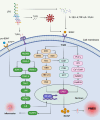The role of the neuroinflammation and stressors in premenstrual syndrome/premenstrual dysphoric disorder: a review
- PMID: 40225329
- PMCID: PMC11985436
- DOI: 10.3389/fendo.2025.1561848
The role of the neuroinflammation and stressors in premenstrual syndrome/premenstrual dysphoric disorder: a review
Abstract
Premenstrual syndrome (PMS) and premenstrual dysphoric disorder (PMDD) are prevalent emotional disorders in females, characterized by cyclic variations in physiological stress responses and emotional symptoms that correspond with the menstrual cycle. Despite extensive research, the underlying causes of these disorders remain elusive. This review delves into the neurobiological mechanisms connecting stress-induced neuroinflammation with PMS/PMDD. Additionally, it traces the conceptual development and historical context of PMS/PMDD. The review further evaluates clinical evidence on the association between PMS/PMDD and stress, along with findings from both clinical and animal studies that link these disorders to inflammatory processes. Additionally, the neurobiological pathways by which inflammatory responses may play a role in the pathogenesis of PMS/PMDD were elucidated, including their interactions with the hypothalamic-pituitary-ovary (HPO) axis, serotonin-kynurenine (5-HT-KYN) system, GABAergic system, brain-derived neurotrophic factor (BDNF), hypothalamic-pituitary-adrena(HPA)axis and. Future research is encouraged to further investigate the pathogenesis of PMS/PMDD through the perspective of neuroinflammatory responses.
Keywords: blood-brain barrier; kynurenine; neuroinflammation; premenstrual dysphoric disorder; premenstrual syndrome; stress.
Copyright © 2025 Cheng, Jiang, Yang, Sun, Song, Du, Luo and Zhang.
Conflict of interest statement
Authors XS, NS, CD, and ZZ were employed by the company Qinhuangdao Shanhaiguan Pharmaceutical Co., Ltd. The remaining authors declare that the research was conducted in the absence of any commercial or financial relationships that could be construed as a potential conflict of interest.
Figures




Similar articles
-
Stress, mood, and cortisol during daily life in women with Premenstrual Dysphoric Disorder (PMDD).Psychoneuroendocrinology. 2019 Nov;109:104372. doi: 10.1016/j.psyneuen.2019.104372. Epub 2019 Jul 23. Psychoneuroendocrinology. 2019. PMID: 31357135
-
Can animal models resemble a premenstrual dysphoric condition?Front Neuroendocrinol. 2022 Jul;66:101007. doi: 10.1016/j.yfrne.2022.101007. Epub 2022 May 25. Front Neuroendocrinol. 2022. PMID: 35623450 Review.
-
Luteal phase sertraline treatment of premenstrual dysphoric disorder (PMDD): Effects on markers of hypothalamic pituitary adrenal (HPA) axis activation and inflammation.Psychoneuroendocrinology. 2024 Nov;169:107145. doi: 10.1016/j.psyneuen.2024.107145. Epub 2024 Jul 24. Psychoneuroendocrinology. 2024. PMID: 39096755
-
Menstrual Cycle and the Prevalence of Premenstrual Syndrome/Premenstrual Dysphoric Disorder in Adolescent Athletes.J Pediatr Adolesc Gynecol. 2015 Dec;28(6):492-8. doi: 10.1016/j.jpag.2015.02.113. Epub 2015 Mar 6. J Pediatr Adolesc Gynecol. 2015. PMID: 26233292
-
A lack of consistent evidence for cortisol dysregulation in premenstrual syndrome/premenstrual dysphoric disorder.Psychoneuroendocrinology. 2016 Mar;65:149-64. doi: 10.1016/j.psyneuen.2015.12.009. Epub 2015 Dec 18. Psychoneuroendocrinology. 2016. PMID: 26789492 Review.
References
-
- American Psychological Association. A.P.A. Diagnostic and statistical manual of mental disorders: DSM-5: American psychiatric association. Washington, DC: American Psychological Association; (2013).
-
- American Psychological Association. A.P.A. Diagnostic and statistical manual of mental disorders, fifth edition, text revision. United States: American Psychological Association; (2022).
-
- Frank RT. The hormonal causes of premenstrual tension. Arch Neurol And Psychiatry. (1931) 26:1053–7. doi: 10.1001/archneurpsyc.1931.02230110151009 - DOI
Publication types
MeSH terms
LinkOut - more resources
Full Text Sources
Medical

